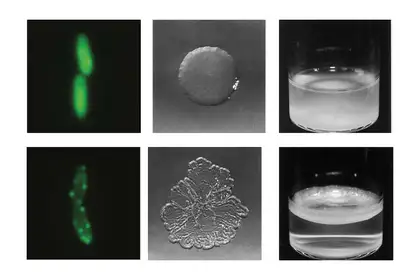
Visualisation of evolution in action, showing both the new gene and the biological function.
Scientists from Massey University have captured the formation of a new gene in real-time evolution experiments.
Just how new genes arise is a problem of fundamental significance and hints from genome analyses suggest a range of possibilities. By observing such events first hand, the scientists have provided much-needed empirical understanding.
Using microbes as experimental tools to study the moment-by-moment workings of evolution, researchers at Massey University’s New Zealand Institute for Advanced Study report spontaneous mutational events leading to the formation of a new gene.
The mutations caused two separate genes to fuse into a single new hybrid gene. Strikingly, the new gene caused a once-cytosolic enzyme to move to the cell membrane, and with re-localisation came a new biological function.
Evolutionary geneticist Distinguished Professor Paul Rainey says that once scientists thought gene duplication followed by divergence was the primary route by which new genes were created. “Scientists are discovering more and more mechanisms, but direct observation of those mechanisms has until now proved elusive.”
“Despite the apparent range of opportunities for the birth of new genes, this is the first time that the birth of a new gene has been captured in real time – the selective events leading to its formation have been understood and mechanistic details underpinning the function of the new gene have been revealed.”
Professor Rainey says that while the creation of this ‘biofilm’ of imagery capturing evolution as it happens may not look significant, it is. “The relative ease by which this new gene arose, along with its functional and regulatory effects, provides a glimpse of mutational events and their consequences that are likely to play a significant role in the evolution of new genes.”
Gene fusions can drive adaptive evolution, but can also have devastating consequences that led to diseases like cancer.
Professor Rainey says they will look to “take experimental evolution ‘into the wild’ and create scenarios more reflective of the complex challenges faced by natural populations in order to shed further light on the origins of genes.”
“We are still finding out more and more about how new genes are generated.”
The study ‘Adaptive evolution by spontaneous domain fusion and protein relocalization’ is published in Nature Ecology & Evolution.